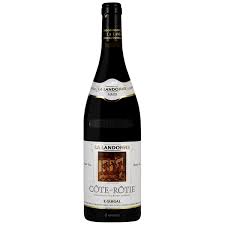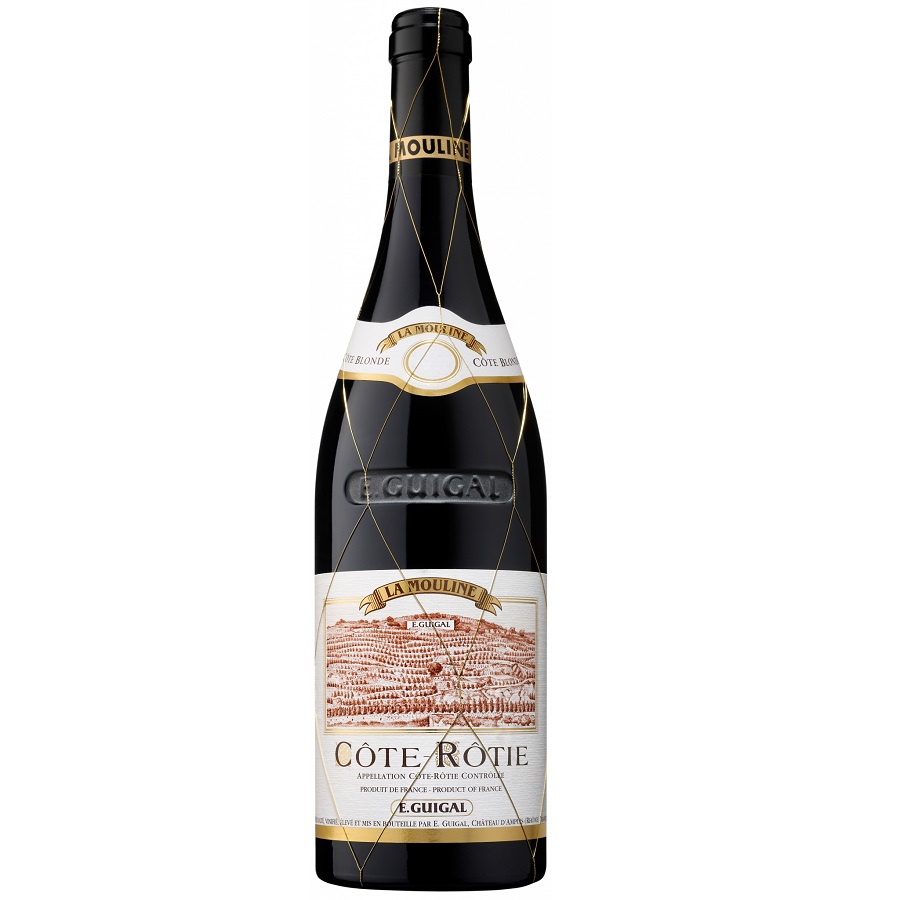2015 E. Guigal Cote-Rotie La Turque
2015 E. Guigal Cote-Rotie La Turque Deep ruby red in color, this wine offers aromas of small red fruit, blackberry and morello cherry. It is intensely aromatic — powerful, but elegant. On the palate, the wine has a balanced, supple structure, with great concentration and elegant tannins. Pair with exceptional food, pheasant, partridge and hare.
Guigal
The Guigal domain was founded in 1946 by Etienne Guigal in the ancient village of Ampuis, home of the wines of the Côte-Rôtie. In these vineyards that are over 2400 years old, you can still see the small terraced walls characteristic of the Roman period. Etienne Guigal arrived in this region in 1923 at the age of 14. He made wine for over 67 vintages and, at the beginning of his career, participated in the development of the Vidal-Fleury establishment.
Despite his young age, Marcel Guigal took over from his father in 1961 when the latter was victim to a brutal illness rendering him blind. Marcel’s hard work and perseverance enabled the Guigals to buy out Vidal-Fleury in 1984, although the establishment retains its own identity and commercial autonomy. In 2000, the Guigals purchased the Jean-Louis Grippat estate in Saint-Joseph and Hermitage, as well as the Domaine de Vallouit in Côte-Rôtie, Hermitage, Saint-Joseph and Crozes-Hermitage.
In the cellars of the Guigal estate in Ampuis, the northern appellations of the Rhône Valley are produced and aged. These are the appellations of Côte-Rôtie, Condrieu, Hermitage, Saint-Joseph and Crozes-Hermitage. The great appellations of the Southern Rhône, Chateauneuf-du-Pape, Gigondas, Tavel and Côtes-du-Rhône, are also aged in the Ampuis cellars.
Cote-Rotie
The cultivation of vines here began with Greek settlers who arrived in 600 BC. Its proximity to Vienne was important then and also when that city became a Roman settlement but its situation, far from the negociants of Tain, led to its decline in more modern history. However the 1990s brought with it a revival fueled by one producer, Marcel Guigal, who believed in the zone’s potential. He, along with the critic, Robert Parker, are said to be responsible for the zone’s later 20th century renaissance.
Where the Rhone River turns, there is a build up of schist rock and a remarkable angle that produces slopes to maximize the rays of the sun. Cote Rotie remains one of the steepest in viticultural France. Its varied slopes have two designations. Some are dedicated as Côte Blonde and others as Côte Brune. Syrahs coming from Côte Blonde are lighter, more floral, and ready for earlier consumption—they can also include up to 20% of the highly scented Viognier. Those from Côte Brune are more sturdy, age-worthy and are typically nearly 100% Syrah. Either way, a Cote Rotie is going to have a particularly haunting and savory perfume, expressing a more feminine side of the northern Rhone.
Related products
2019 Laurent Martray Cote de Brouilly Les Feuillees 2019 Laurent Martray Cote de Brouilly Les Feuillees is especially compelling, unfurling in the glass with aromas of cherries, wild berries, warm spices, peonies, licorice and orange rind. Medium to full-bodied, layered and multidimensional, it’s velvety and concentrated, with lively acids and a long, resonant finish. This [...]
2020 Francois Villard Condrieu De Poncins 2020 Francois Villard Condrieu De Poncins Full-bodied, with quite noticeable oak at this stage. Wonderful sense of freshness, however, and great precision. Long, lush and generous yet defined, this is a very classic Condrieu in all its resplendent flamboyance. Cooling almond and coconut on the finish. From 25-year-old Viognier [...]
Burgundy
2019 Nicolas Rossignol Volnay 2019 Nicolas Rossignol Volnay is medium to full-bodied with aromas of plums, wild berries, warm spices and licorice, fleshy and layered, with fine concentration, lively acids and an ample core of fruit. Concluding with elegantly chalky grip on the finish, this cuvée has always been one of the more charming and immediate [...]
2016 Domaine Armelle et Bernard Rion Nuits-Saint-Georges 1er Cru Les Damodes 2016 Domaine Armelle et Bernard Rion Nuits-Saint-Georges 1er Cru Les Damodes is light and elegant for the appellation. On palate, high acidity with smooth tannis together with balanced fruits and oak flavor. 2016 vintage Les Damodes is a premier cru site on the Nuits-Saint-Georges [...]



